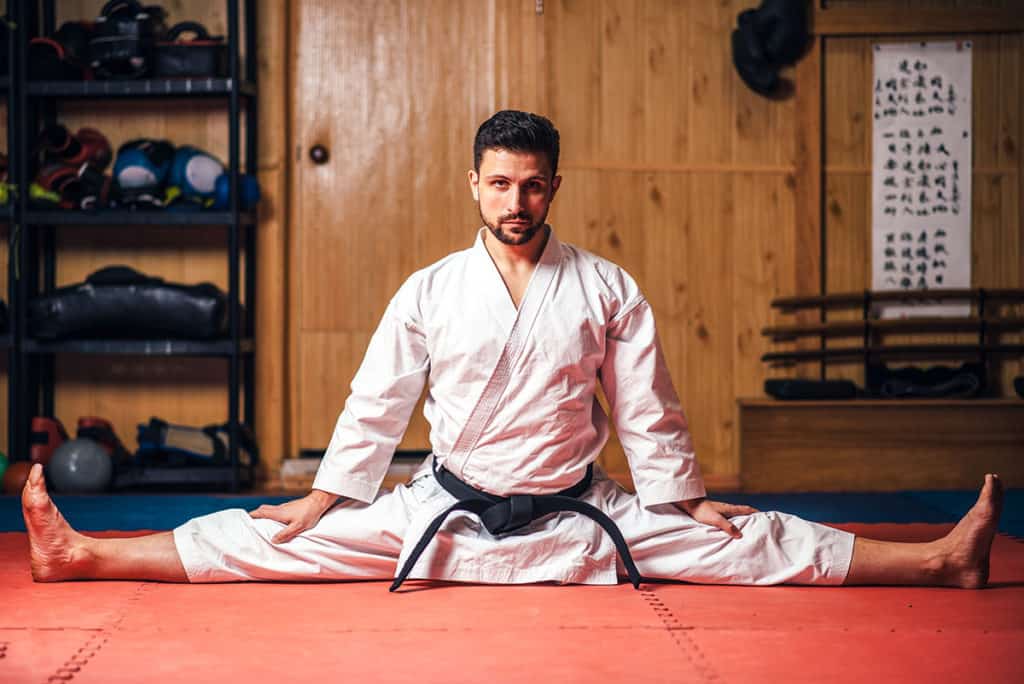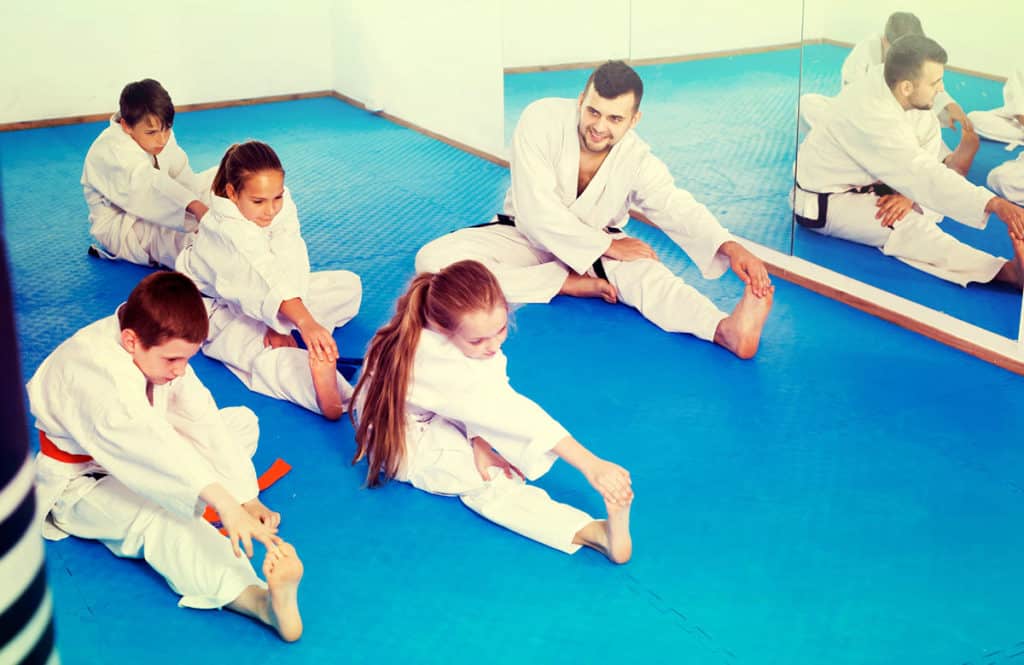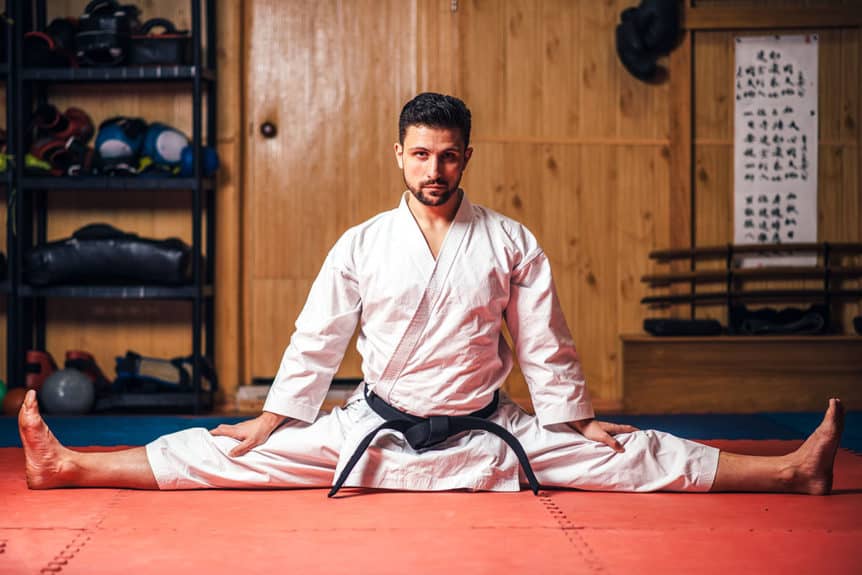
Taekwondo’s kicks is what set it apart from other martial art styles. Although jump kicks, spinning kicks, and high kicks are impressive to watch, you will even have fun learning them as a Taekwondo student (Hak Saeng) However, they are hard to do if you are not flexible enough.
How does stretching improve flexibility in your practice of Taekwondo? Stretching gives you better flexibility and enables you to deliver kicks with precision, It also improves your strength, relieves stress from muscles, and also improves your balance .
Since, flexibility is one of the most significant aspects you must master while participating in any form of physical activity, this is especially tru e with TaeKwondo. Lets go talk about how to get more flexible.
Why Stretching helps Flexibility in Taekwondo
Every fitness expert and the martial artist will agree that it is vital to stretch your body to improve and maintain flexibility throughout life. It will significantly improve performance and allow you to use Taekwondo more effectively for sparring in class and in tournaments
A good kicking technique requires dexterity, flexibility, and mobility of the joints, especially the hip joint. Flexibility is an art itself, and it contributes to improving your strength and stamina while learning Taekwondo.
However, as you do not become a black belt overnight, the ability to flex and stretch your body in a wide range of motion is no different. In order to do this, you will have to fit it into your daily regime to hone this skill.
For example, if you want to perform dollyo cha-gee or a turning kick, you must rotate dynamically with the ability to deliver a head-high kick to someone. Flexibility will help you perform this kick by increasing the range of motion in your body.
How? The answer is three words stretch, stretch, and stretch.
You just need to keep pushing your limits and go a bit further every time. You may already be aware of some of the benefits of stretching. Today, you will learn all you need to know about stretching in Taekwondo.
Stretching for TaeKwonDo
Everyone who practices TaeKwondo, is well aware of how stretching benefits their kicking techniques and improves their performance.
For every martial artist, a time comes when you hit a plateau. As a Taekwondo martial artist, you must push the boundaries and excel. You can do so by readjusting your routine every couple of months.
You must remember that during your Taekwondo training sessions, you will have a certain amount of time to stretch. Of course, your instructor can allot so much of the time for stretching, for example, you may have to stretch and hold a position for 20 or 25 seconds maximum.
However, do not set this duration as a benchmark for your stretching postures. When you are home practicing stretch, hold the posture for as long as you can; this is very beneficial on many levels.
Not only does it strengthen your muscles, but it also enhances your stamina, flexibility, balance, and much more. A good bench mark is to aim for 60 seconds per stretch.
Flexibility will also improve your speed as it allows your muscles to be less resistant to different postures and movements. Hence, you can deliver your chigi, moreup, and cha-gee, with precision and speed.
Remember, flexibility is one of the most effective and powerful techniques in your arsenal as a Taekwondo martial artist. You can master it through stretching. Not only will it improve your sparring performance, but it will also prevent injuries. It may be simple, but it is effective; therefore, do not overlook it during your Taekwondo training.
Static Stretching
Static stretches require you to stand, lie, or sit still and hold a specific position or posture for a period of up to 45 seconds. In static stretching, you must move a muscle to its maximum range of motion, hold it there without pain for 20 to 45 seconds, and let go. Repeat each stretch two to three times.
You must do these stretches during cool-down after the training session. Static stretches after training or combative session in Taekwondo helps prevent injuries. However, do not use static stretch as a warm-up before your Taekwondo competition, as it may affect your performance. Why? Because static stretches may limit your body’s reflex action or ability to react quickly.
Some examples of static stretching are:
Posterior Capsule posture
Relax your shoulder and bring one arm across your body. Now, hold this arm with the other arm right above the elbow, and pull it gently towards your body.
Hamstring Stretching
Although you can do so by lying on your back and ask your partner to help stretch by applying pressure, you can also do so by yourself while standing. First, all you need is a low stool to place your leg on. Ensure your hips and feet are facing forward.
Now lean forward from your hips while keeping your knees straight and back flat. Keep going till you feel the stretch in the back muscles of your thighs. These stretches prevent any leg injuries during your Taekwondo session, whether you are sparring in a tournament or in your school.
Quadriceps Stretching
This stretching involves holding an ankle with hand. For example, hold your right ankle with the right hand and tighten your abdominal muscles to prevent the arching of your back.
Now, extend the thigh backward by bending your knee and try to bring your ankle upwards towards the buttocks. Keep going till you feel the stretch in the front of your thigh. This stretch benefits your quadriceps muscles.
Crouching Stance From Side to Side
It is also known as “tame the tiger stance” or Fu Hu Bu. It is an excellent stretching exercise for taekwondo martial artists. Squat on your left leg and aim your thigh to be precisely parallel to the ground. Now extend the right leg out to the side.
Both feet must be identical to each other and facing forward. Try to stretch as far to the left as you can, and you can rest your arms on the waist. Stretch for 10 seconds and switch the stance by shift slowly towards the right, and now squat on the right leg and stretch the leg out the side. Repeat this 8 to 10 times on each leg.
Dynamic Stretching
Dynamic stretching is useful as your warm routine before a combat session. Do your warm-up first and then a dynamic stretching session for 5 to 10 minutes, whether it is a competition or just for training. Dynamic stretches are a set of controlled movements to prepare your soft tissues, ligaments, and muscles for endurance, performance, and safety.You can also use dynamic stretching as a cool-down regime, while you can use static stretching as a maintenance regime to avoid injuries.
Side Neck Rotation Stretch
Slowly move your neck to the left and keep going till you feel the tension in your muscles. Now slowly move the neck back to center and move the neck to the right and back again. Repeat this exercise 8 to 10 times on each side. This stretch improves the range of your neck movement and is useful for all spins.
Progressive Air Circle
Stretch your arms outwards to the sides. Now start rotating your arms in circles; five forward and then five back. Start with small circles and gradually increase the size of the circles you make while rotating. This stretch is beneficial for shoulder mobility and is very useful for blocking and all hand techniques in Taekwondo.
Wrist Circles
Keep your elbows at 90 degrees with loose fists. Now rotate the fist inwards 10 to 12 times, and then outwards 10 to 12 times. Not only does it enhance your range of motion, but it also improves the blood flow. This motion is useful for blocking and all hand techniques.
Walking Knee Hug
Lift your left knee, grab it with both hands, and pull it towards your chest and hold it there for 2 seconds. Now raise your right toes and slowly release your knee while you do so, and step forward. Now switch legs and repeat these stretches at least eight times each leg. This motion is useful for stances and kicks; plus, it is beneficial to enhance the range of motion in the lower back and hip flexors.
Inchworm
Keep your feet shoulders apart and bend forward to touch the floor. You can bend the knees if needed. Now slowly walk your hands out to plank position and hold that posture for 2 seconds, and then walk them back towards your feet. Repeat this 8 to 10 times. This stretch improves mobility in your back muscles, calves, shoulders, and hamstrings. You can use these muscles in all Taekwondo moves.
Forward Leg Swinging Up
After all, Taekwondo is all about high kicks; therefore, the higher your kicks, the better. Forward leg swinging up is one of the best dynamic stretches for your legs to enhance your kicks. Support yourself with one hand on a wall or a post, keeping your face looking straight. Swing your left leg back and forth like a pendulum. Make sure to keep your core engaged and your posture tall.
Do not be aggressive at the beginning; take it slow, and gradually increase the range of your swing. Relax your hip joints as much as possible, and as the blood rushes through your muscles, you will feel them loosen up. Do 20 swings each leg. It is good for your legs, hip flexors, and hamstrings.
Butterfly
Butterfly stretch is one of the fundamental stretched in Taekwondo and one that must be done properly in order to get its maximum benefit. To start with sit on the floor and bend your legs inwards and bring your feet together, so their bottoms are touching each other
Try to bring your heels as close to your groin area as possible. The closer, the better. Your legs and knees bent should resemble butterfly wings (hence the name).Now, gently flap your legs like butterfly wings.
As you flip your legs up and down, try to touch your feet with your forehead. However, this will come with time. As you practice, you will be flexible enough to touch, not just your forehead but your chest as well.
Flexibility as Adults and Children

Taekwondo is for all ages. However, both adults and children have different beneficial advantages. It is safe to say that children are more flexible naturally than adults. However, there is always room for improvement, and stretching is the way to get there. If they train, children are likely to gain flexibility more quickly than adults. However, adults have more room to show a greater improvement following a strict stretching exercise regime.
Children need to focus on their flexibility as they grow because during their rapid growth period, their flexibility will decrease if not stretching regularly. Therefore, if a child lacks flexibility naturally, then the best time to start working on increasing the flexibility is before they hit the growth spurt period. The longer you wait, the harder it will be for them to improve flexibility and adults are a prime example of this.
To improve flexibility, both adults and children must practice proper warm-up stretches and exercises. They must also perform stretches during their cool-down after a competition or a training session. In addition to maintain flexibility, it can help prevent injuries and improve their TaeKwonDo skills and performance.
Final Tip
Always remember safety comes first. Do not push too hard; this is important to avoid injuries. We all have our limitations, and that is ok. Partnered stretching is a recommended way to approach this regime.
However, find a Taekwondo partner who can train with you daily and knows your physical limitations. Communication is the key here; for example, it is a good idea to lie on your back and offer your legs to your partner to stretch your hamstring. However, both of you need to be careful about pressure applied, therefore talk to each other.
Do you not have a partner? No problems – Use a skip rope or a belt as an aid. Breathing in is another crucial Taekwondo technique. Breathe in as you get ready to stretch and breathe out as you execute it. Relax and breathe normally as much as you can while holding the stretch. Chari – yut – Sijak!

